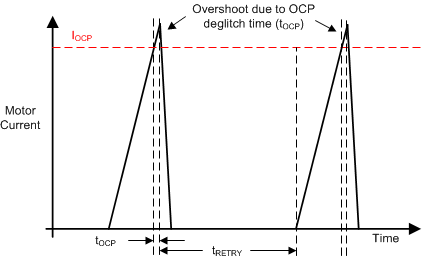JAJSSJ5 December 2023 DRV8234
PRODUCTION DATA
- 1
- 1 特長
- 2 アプリケーション
- 3 概要
- 4 Device Comparison
- 5 Pin Configuration and Functions
- 6 Specifications
-
7 Detailed Description
- 7.1 Overview
- 7.2 Functional Block Diagram
- 7.3
Feature Description
- 7.3.1 External Components
- 7.3.2 Summary of Features
- 7.3.3 Bridge Control
- 7.3.4 Current Sense and Regulation (IPROPI)
- 7.3.5 Stall Detection
- 7.3.6
Ripple Counting
- 7.3.6.1
Ripple Counting Parameters
- 7.3.6.1.1 Motor Resistance Inverse
- 7.3.6.1.2 Motor Resistance Inverse Scale
- 7.3.6.1.3 KMC Scaling Factor
- 7.3.6.1.4 KMC
- 7.3.6.1.5 Filter Damping Constant
- 7.3.6.1.6 Filter Input Scaling Factor
- 7.3.6.1.7 Ripple Count Threshold
- 7.3.6.1.8 Ripple Count Threshold Scale
- 7.3.6.1.9 T_MECH_FLT
- 7.3.6.1.10 VSNS_SEL
- 7.3.6.1.11 Error Correction
- 7.3.6.2 RC_OUT Output
- 7.3.6.3 Ripple Counting with nFAULT
- 7.3.6.1
Ripple Counting Parameters
- 7.3.7 Motor Voltage and Speed Regulation
- 7.3.8 Protection Circuits
- 7.4 Device Functional Modes
- 7.5 Programming
- 7.6 Register Map
-
8 Application and Implementation
- 8.1 Application Information
- 8.2 Typical Application: Brushed DC Motor
- 9 Power Supply Recommendations
- 10Layout
- 11Device and Documentation Support
- 12Revision History
パッケージ・オプション
メカニカル・データ(パッケージ|ピン)
- RTE|16
サーマルパッド・メカニカル・データ
- RTE|16
発注情報
7.3.8.1 Overcurrent Protection (OCP)
An analog current limit circuit on each FET limits the current through the FET by limiting the gate drive internally. If this analog current limit persists for longer than the OCP deglitch time (tOCP), all FETs in the H-bridge will disable, FAULT and OCP bits become 1b and nFAULT is pulled low.
The OCP_MODE bit programs the response of the device to overcurrent event. The device can either latch-off or perform automatic retry to recover from an overcurrent event.
In automatic retry mode, the MOSFETs will be disabled and the nFAULT pin driven low for a duration of tRETRY. After tRETRY, the MOSFETs are re-enabled according to the control inputs. If the overcurrent condition is still present, the cycle repeats; otherwise normal device operation resumes. This is explained by the following diagram -
 Figure 7-17 OCP Operation
Figure 7-17 OCP OperationIn latch-off mode, the MOSFETs will remain disabled and the nFAULT pin will be driven low until the device is reset by a CLR_FLT command or by cycling the VM power supply.
Overcurrent conditions are detected independently on both high- and low-side FETs. This means that a short to ground, supply, or across the motor winding will all result in an overcurrent shutdown. Overcurrent protection does not use the current sense circuitry used for current regulation, so it functions regardless of VREF and IPROPI settings.